Delving into the world of traditional food in Lisbon when you don’t speak the lingo is, in my view, one of the joys of being in Portugal’s capital city. This is because the food scene in Portugal is incredible. Even ordering blind and just pointing to the first thing on the menu will probably yield something hearty, refined and delicious. However, it would probably be wise to look into the food culture of the city before arriving, not only to prepare your tastebuds for what awaits, but also to help you plan where you can get your hands on these delights. This post is a foodie’s guide to the city, full of recommendations of what and where to eat traditional food in Lisbon, including, of course, some its most famous and authentic dishes. If eating like a local is at all important to you when abroad, then do get stuck into some of these dishes, and check out one of the many Lisbon food tours that are available, just come hungry…
Traditional food in Lisbon - 11 things you need in your mouth to eat like a local
But before we begin... Oh my cod! What's with Lisbon's obsession with Bacalhau?
Bacalhau (salted codfish) is EVERYWHERE in Lisbon, which is kind of strange because cod mostly swim in the north Atlantic, typically in Icelandic, Norwegian and Canadian waters. However the import of salted cod has been an important part of Portuguese trade and culture for centuries, and the Portuguese people are the undisputed masters of cooking it (although I’m sure a few Brits may have something to say about that). Because Bacalhau has been salted, dried and then rehydrated, it retains its texture and flakiness and doesn’t just turn into mush, making it suitable for use in wide variety of dishes (see below). If all this is music to your ears, then why not visit Lisbon’s ‘Codfish History Interpretation Centre’?! Anyway, let’s get straight onto the top foods to try in Portugal instead…
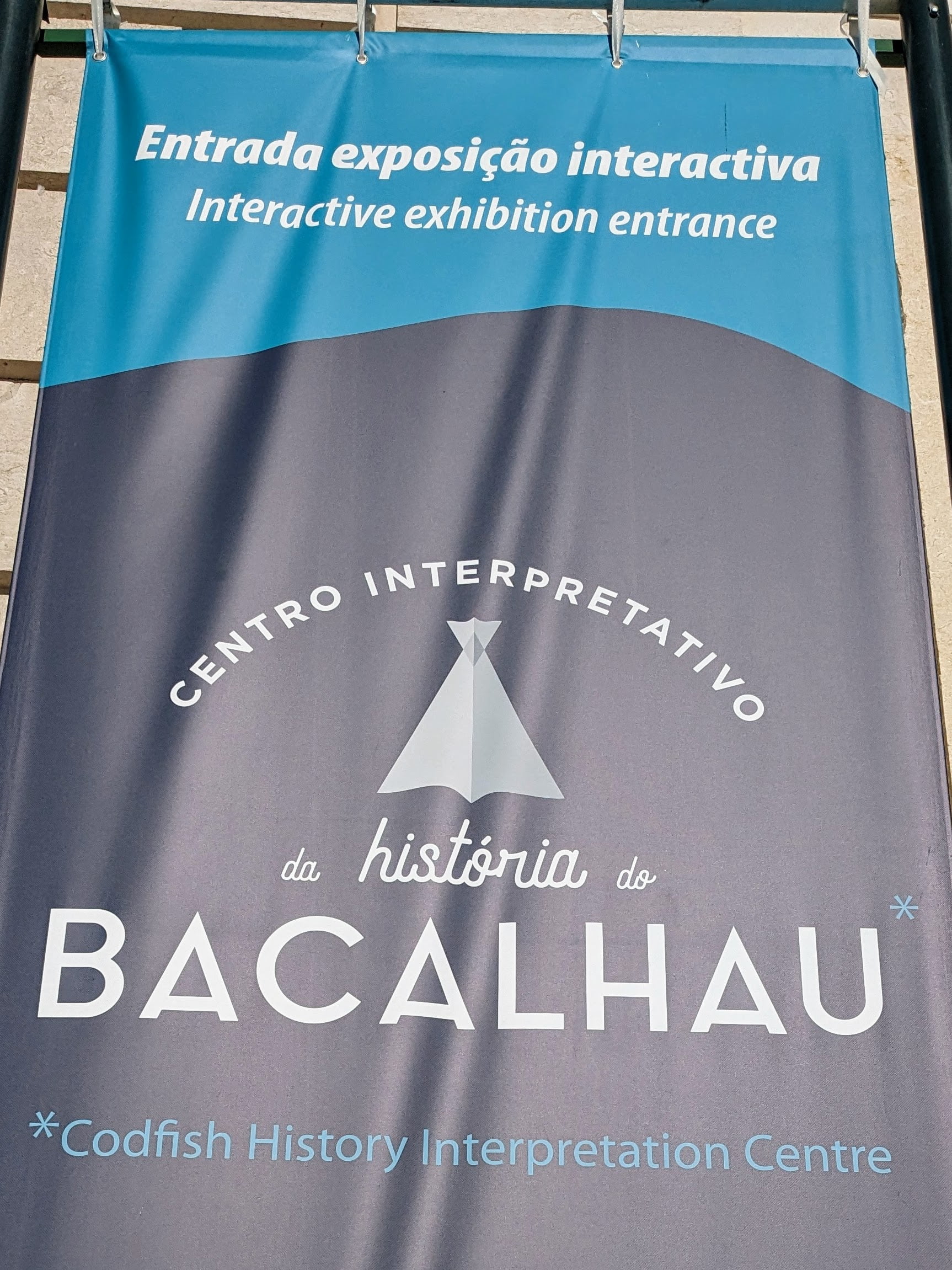
Authentic Portuguese Food in Lisbon: Bacalhau
1. Pastéis de Bacalhau
Pastéis de Bacalhau, also known as codfish cakes or salt cod fritters, are very popular in Lisbon. These savory snacks are made with salted cod (bacalhau), potatoes, onions, garlic, and parsley. On one the main shopping streets, you’ll find Casa Portuguesa do Pastel de Bacalhau, where you can watch them preparing these cod fritters. They also sell a version filled with molten hot cheese, but beware, and it may explode all over your jumper upon first bite, just as mine did.
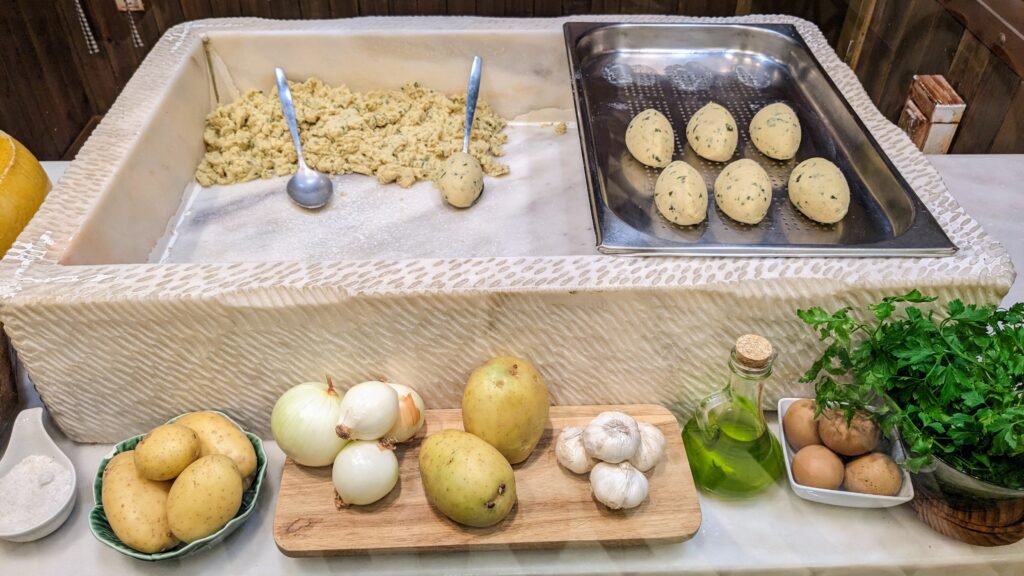
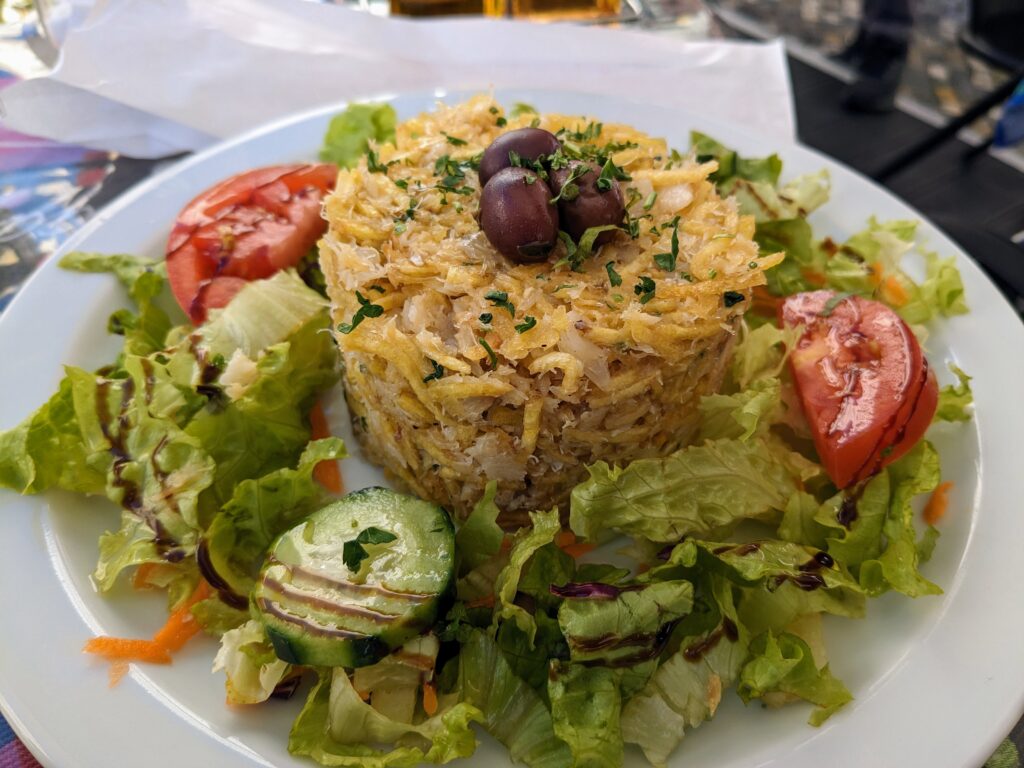
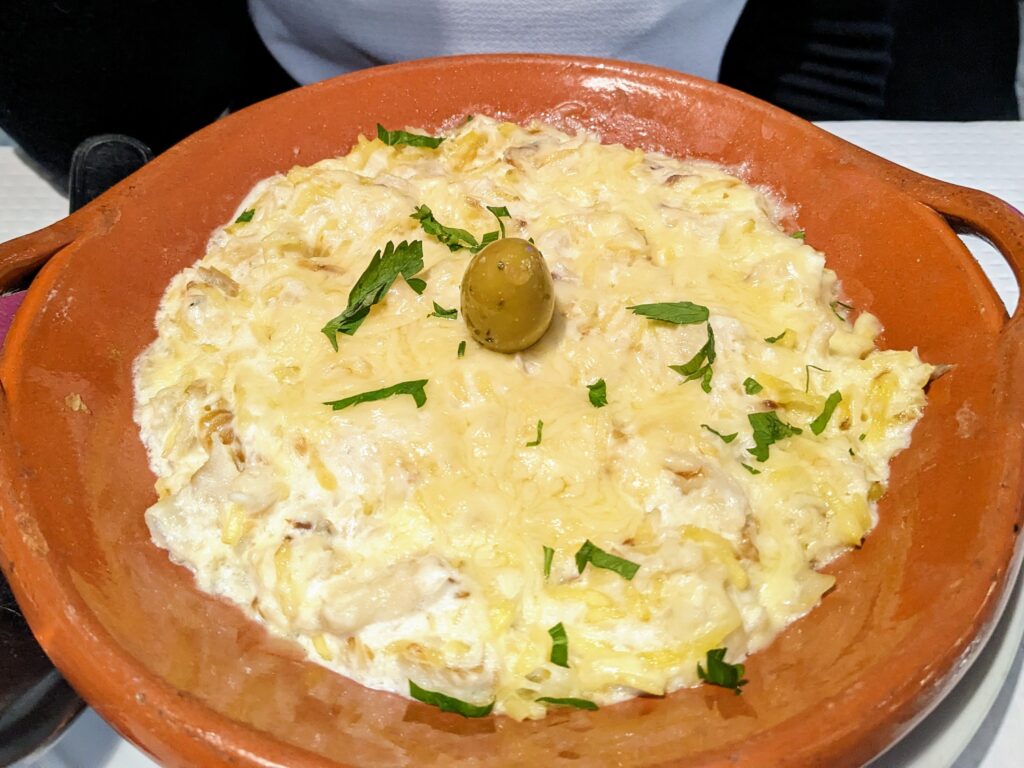
2. Bacalhau à Brás
“Bacalhau à Brás” is a traditional Portuguese dish that features cod cooked with onions, fried shredded potatoes, eggs, and parsley. It’s a hearty dish, as this is Lisbon comfort food extraordinaire.
3. Bacalhau com Natas
Bacalhau com Natas is another popular food in Lisbon, known for its creamy and comforting characteristics – like eating a creamy duvet. This dish typically includes layers of salted cod, potatoes, onions, and a rich béchamel-like sauce made with cream. It may not look like much, and gets a bit samey towards the end, in my view, but it will fill you right up after a big day of pounding Lisbon’s seven hills! If none of these three codfish dishes do it for you, then no worries, as there are literally hundreds of other ways that the Portuguese people prepare salted cod.
What to eat in Lisbon: other seafood dishes
4. Gambas à guilho
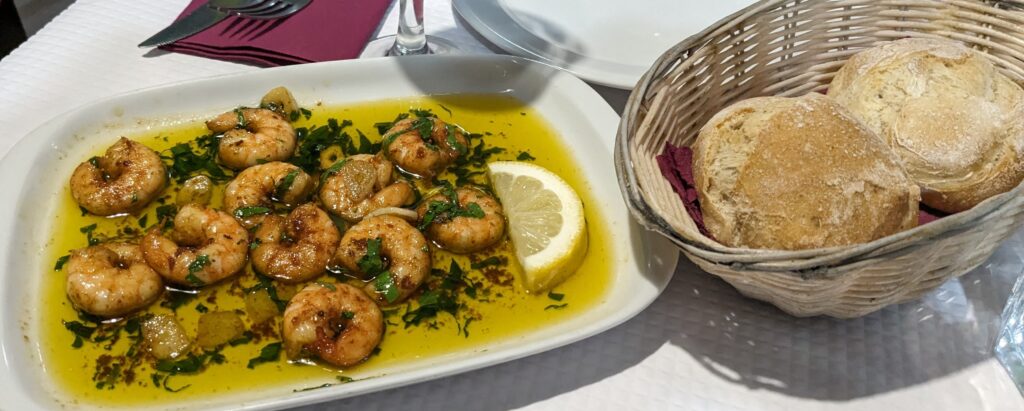
“Gambas à Guilho” is a popular Portuguese dish featuring prawns (gambas) in an amazingly simple but absolutely mega olive oil, garlic, parsley, and white wine puddle. The dish is known for its simplicity, allowing for the natural sweetness of the prawns to shine in the garlic infused olive oil. It’s eaten most often as a starter and it must be consumed with crusty bread and a chilled glass of Portuguese white. If you don’t soak up all that incredible garlic oil with that crusty bread, you need to take a long hard look at yourself. Gambas à Guilho is simple seafood done excellently well, just don’t overcook the prawns if you’re trying it at home.
5. Polvo (octopus)
Much like cod, albeit to a lesser extent, Octopus is prepared in so many different ways, and has become one of Lisbon’s signature meals. Polvo à Lagareiro (grilled octopus) is a classic Lisbon favourite with its tender inner and crispy and smoky outer. Usually drowned in garlicky olive oil and served with smashed skin-on potatoes it is indeed a winner. Arroz de Polvo (octopus rice) is more of a comforting and hearty dish, where, rather predictably, the octopus is cooked with rice, tomatoes, onions, and various seasonings in one pot. For a lighter option, or if you’re trying to shed some pounds, they even do octopus salads.
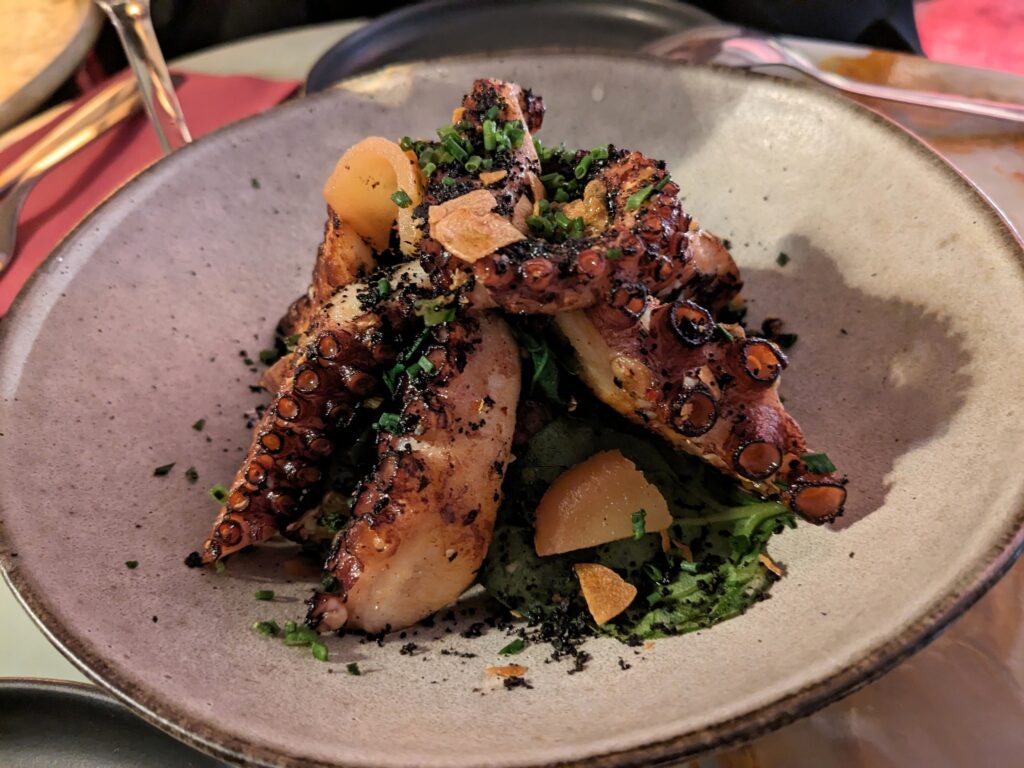
6. Sardinhas Assadas (grilled sardines)
Sardines are an iconic dish in Lisbon, reflecting the city’s maritime traditions and its proximity to the Atlantic Ocean. Freshly grilled sardines go down especially well during Lisbon’s popular Santo António Festival (or the Festas de Lisboa) in June. These are typically seasoned with sea salt and olive oil, then grilled over an open flame to be served immediately by street vendors or at local restaurants. If you’re visiting Lisbon outside of the peak summer months, then you could pick up a few tins of sardines instead. These are often elaborately decorated and make a perfect gift for friends or family, because nothing says ‘I missed you’ like fish. You can also visit to the ‘Mercado da Ribeira’ (Time Out Market) to soak up more sardiney sights and smells, hmmm.
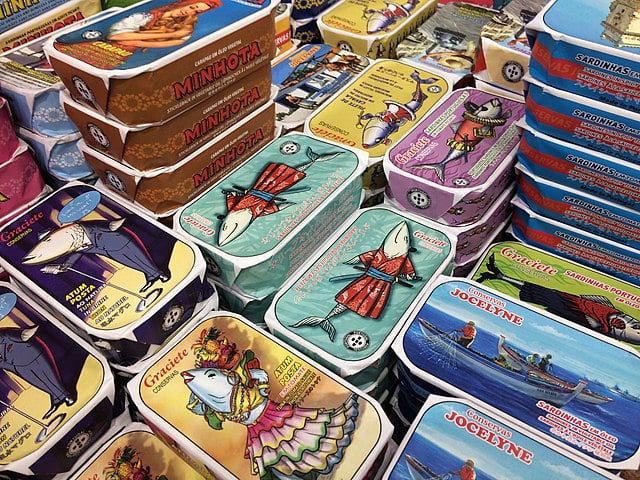
Traditional food in Lisbon: back on dry land
7. Frango Peri Peri (chicken piri piri)
Frango means chicken. “Peri Peri” is a type of chili pepper. Frango Peri Peri together is a dish of grilled marinated chicken pieces, using a sauce made with Peri Peri chili peppers, garlic, olive oil, lemon juice, and various spices. Peri Peri chicken, also known as Piri Piri, is a popular dish in Portugal and its African colonies, Angola and Mozambique. In Lisbon, Frango Peri Peri is usually served with rice, fries, grilled vegetables, or a salad. The popularity of Frango Peri Peri has extended way beyond its Portuguese and African origins, and thanks to Nando’s Peri Peri chicken can now be found on many high streets across Europe, but of course the real thing in Lisbon is far superior.
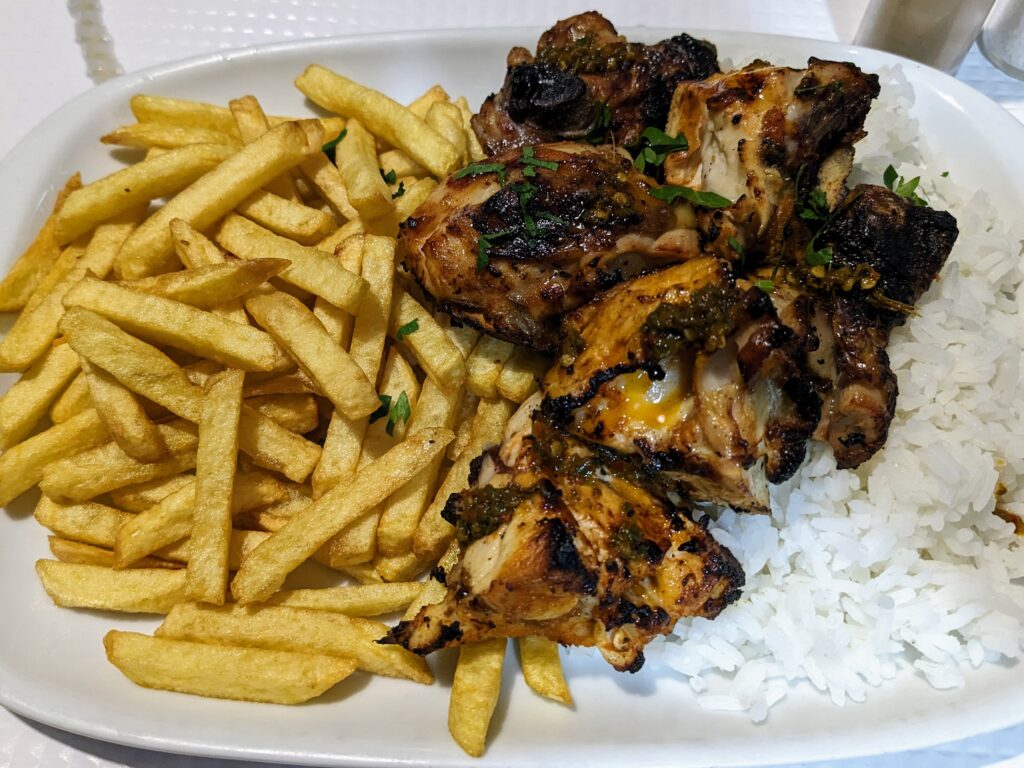
8. Feijoada
Feijoada is a slow-cooked Portuguese stew with black beans and a variety of meats. It was brought to Brazil by Portuguese colonizers in the 16th century and while there, the dish underwent further development and adaptation, becoming influenced by the culinary practices of African slaves and indigenous communities. It found its way back to Portugal and is now a very popular and hearty dish to be enjoyed across Lisbon.
9. Queijo de Azeitão
This sheep’s milk cheese, hailing from the Azeitão region near Lisbon is classified as a “DOP” (Protected Designation of Origin), which means that only cheeses produced within the specified region and following specific production methods can bear the name Queijo de Azeitão. The rind is thin, and the interior is soft and buttery so it’s mostly spreadable. Much like any good cheese, the taste becomes more intense as it matures. The cheese is typically small and round and it is often served as a starter or pre-meal snack at restaurants. It’s bloody delicious with crusty bread and a bit of local charcuterie too!
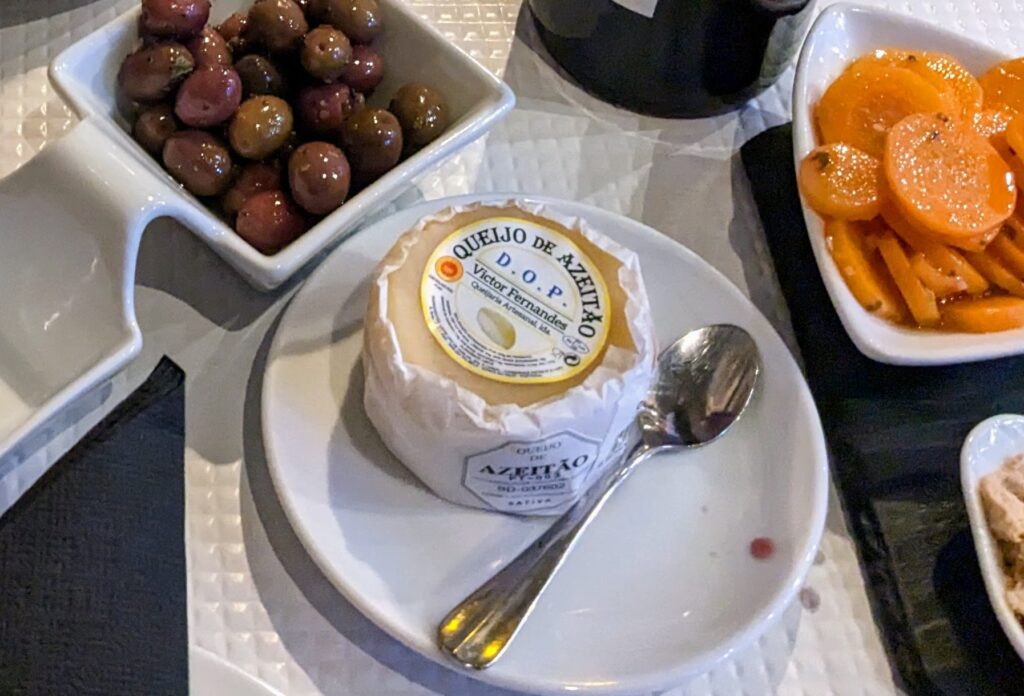
10. Bifanas, Pregos and Sande de Leitão
I first had a Bifana as part of a food tour that was nearing its end, so apologies for the crap photo, but I was already a little drunk by this point and clearly I made very little effort to get a good shot. A Bifana is tender marinated pork loin served in a typical Portuguese crusty roll. Add either either mustard or peri peri sauce. This makes ideal street food or a quick lunch for anyone visiting the city, as does it beef version, called a Prego, and the suckling pig and crispy crackling sandwich, called a Sande de Leitão. Especially good when you’re on the go and just want something quick, yet typically Lisbon.
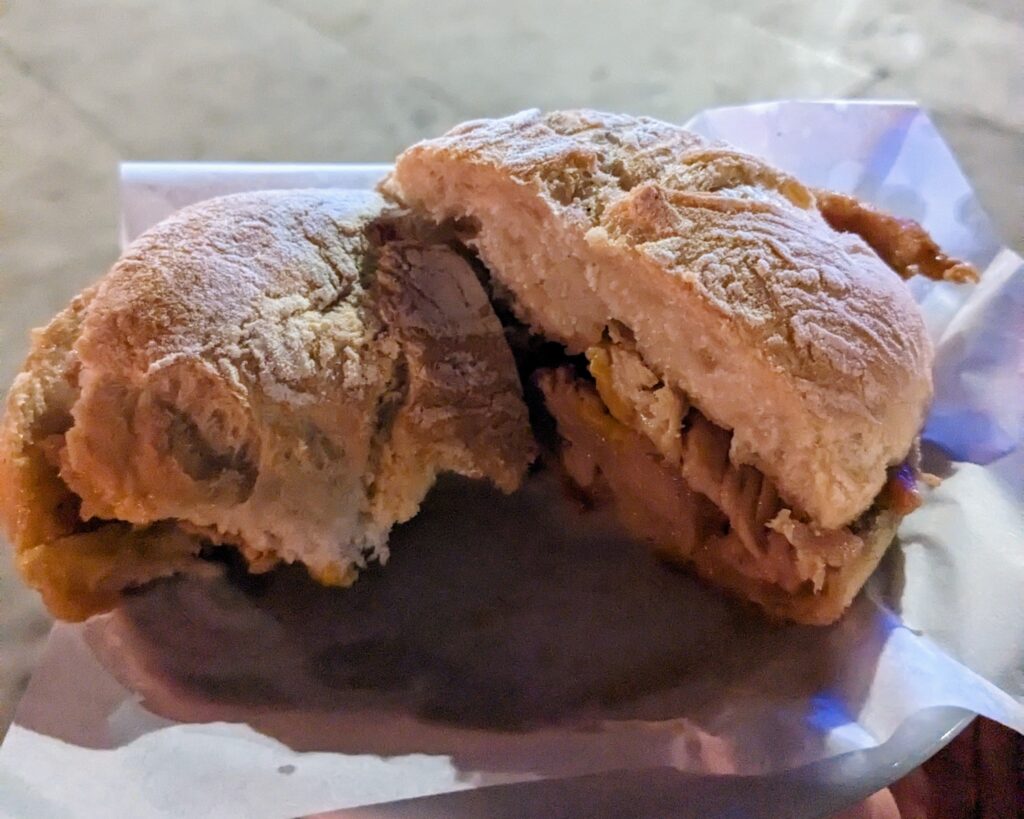
Authentic food in Lisbon - Dessert
11. Pastel de Nata (no list of what to eat in Lisbon would be complete without it!)
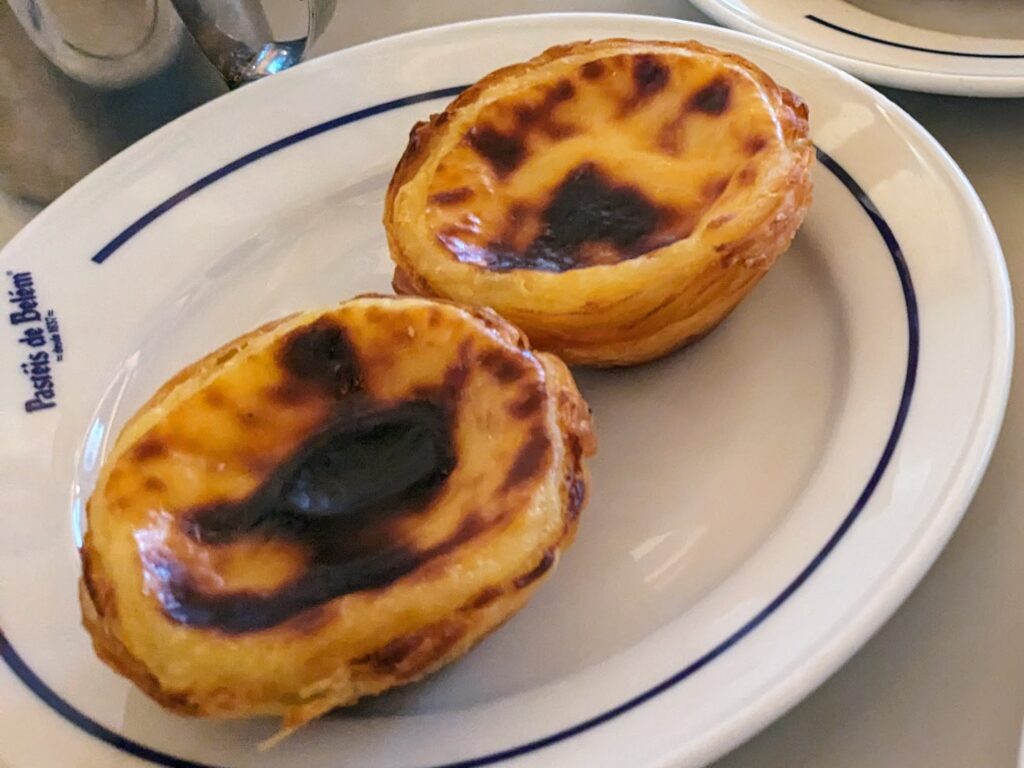
What is Pastel de Nata?
A Pastel de Nata is basically a Portuguese custard tart with a beautiful flaky pastry crust. The custard filling is typically made with a combination of egg yolks, sugar, milk, and vanilla. You’ll find them everywhere in Lisbon and in Portugal. Nowadays you’ll probably be able to find them in your home country too, albeit nowhere near as good as the originals to be found in Portugal, and Lisbon in particular.
What is the history of Pastel de Nata?
Its origin is often credited to the Jerónimos Monastery in the Belém district of Lisbon. The story goes that in the 18th century, monks at the monastery used egg whites to starch their religious garments, resulting in a surplus of egg yolks. To avoid wasting them, the monks began making pastries with the leftover egg yolks, creating what would later become the pastel de nata. The recipe for pastel de nata was initially kept a closely guarded secret within the monastery. However, during the liberal revolution in the 1820s, many religious institutions were shut down, and in 1834, the Jerónimos Monastery closed. At that point, the recipe was sold to a local sugar refinery, which eventually led to the establishment of the famous Pastéis de Belém bakery in 1837. Pastéis de Belém continues to operate and is renowned for its traditional pastel de nata. While Pastéis de Belém is perhaps the most famous purveyor of pastel de nata, these delicious custard tarts have become a staple in Portuguese cuisine, and various bakeries and pastry shops across Portugal produce their own versions. Another option in downtown Lisbon would be Manteigaria, who, in my view, actually make better Pastel de Nata than the overly touristy Pastéis de Belém.
The best Lisbon food tours
I was all about sampling as much traditional food in Lisbon as possible, so the first thing I did upon arrival to Portugal was join a Lisbon food tour. For me, food tours are a great way to immediately get a feel for a new place, while also learning about its history and food culture. You can learn so much about a city just by chowing down on its most famous dishes, especially if you have a well informed guide who offers interesting commentary to accompany the food and drinks.
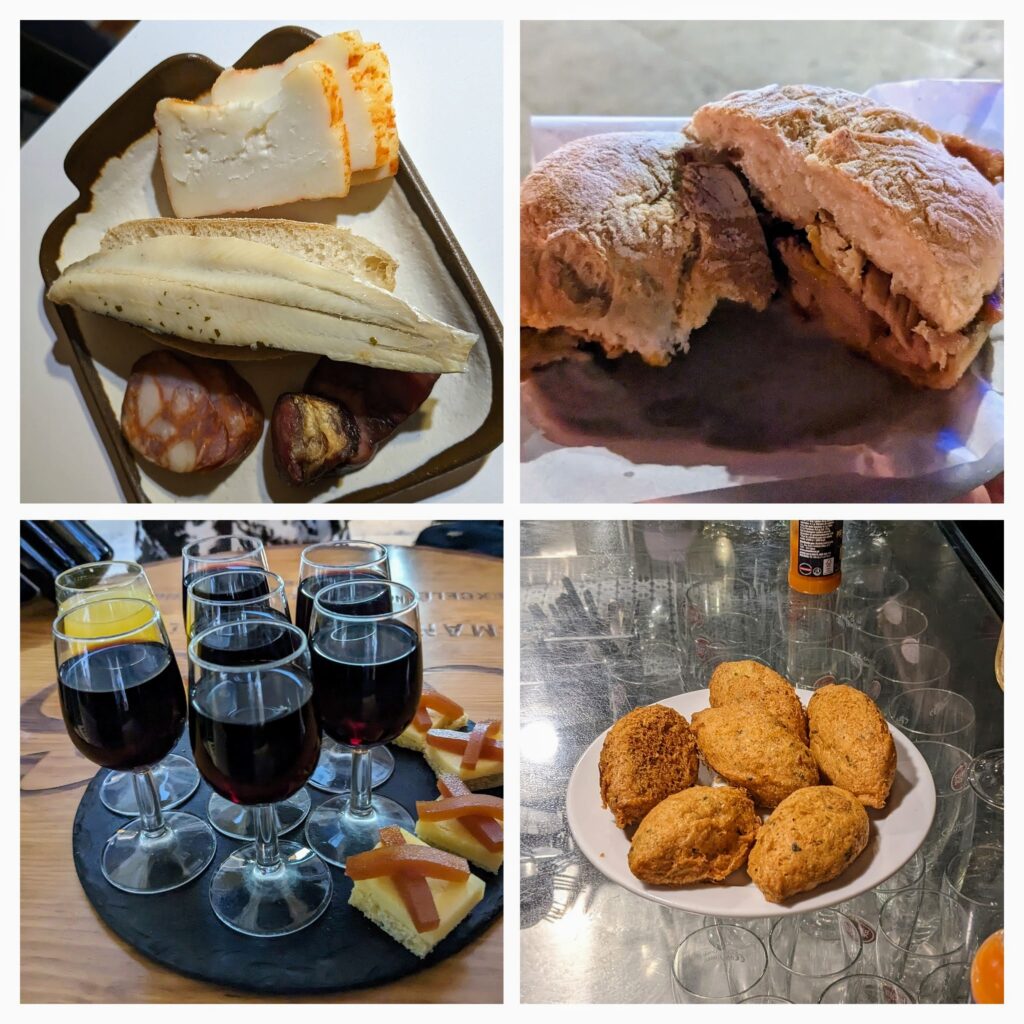
I did this Food and Wine Walking Tour with Inside Lisbon, and it was a very interesting introduction into both the food culture of Lisbon, and the city as a whole. Our guide was enthusiastic and informative, and luckily for us, was also a history major at university, so we got detailed background info on the cultural and historic trends which have shaped the way that the Portuguese eat over the centuries. We sampled cod fritters, several wines, cheeses and cured meats, and we enjoyed a Bifana too. It was boozy, informative and fun, and I can thoroughly recommend it.
Alternatively you can check out the Tastes and Traditions of Lisbon Food Tour from Devour Tours. If you book directly with them you’ll get it cheaper than if you use Get Your Guide or Viator, and it seems to be the most highly rated of all the Lisbon food tours that I researched. The next time I’m in town I will definitely be doing this tour.
If you prefer a more sociable experience, which lets you connect with local chefs and other travellers, then check out a dinner party with Eat With. They provide a platform for talented local cooks to host international travelers in their own homes, so aside from eating some of the best food in Lisbon, you’re meeting Lisbon natives, getting insider tips for the rest of your stay, and potentially making long-term friends. And if you want to learn how to cook it and not just eat it, then then also offer a number of different cooking classes in Lisbon too, including my favourite, where you’ll learn how to make the famous Pastel de Nata in a Lisbon pastry shop!
my favourite traditional restaurant in Lisbon
I’ve been told that I love a bold statement from time to time, so here’s another one – I’ve eaten in the best restaurant in Lisbon, and the food was only an 8 out of 10. That’s because it was all about the owner, Dom Luis, an elderly Portuguese man who was bursting with so much character, authenticity and life spirit that it made the food taste better and the wine remarkable. This very local place will not be for everyone, and some may be put off by the owner’s eccentric ways (or the disposable tablecloths), but for me, this restaurant was an original in a world already too full with overpriced tasting menus. The food and wine was incredible value and plentiful, and I’ve never had such an entertaining dining experience in all my travels. The experience was made all the more special upon finding out that it was Dom Luis’ wife of more than 50 years toiling away in the kitchen while he was masterfully working the room.
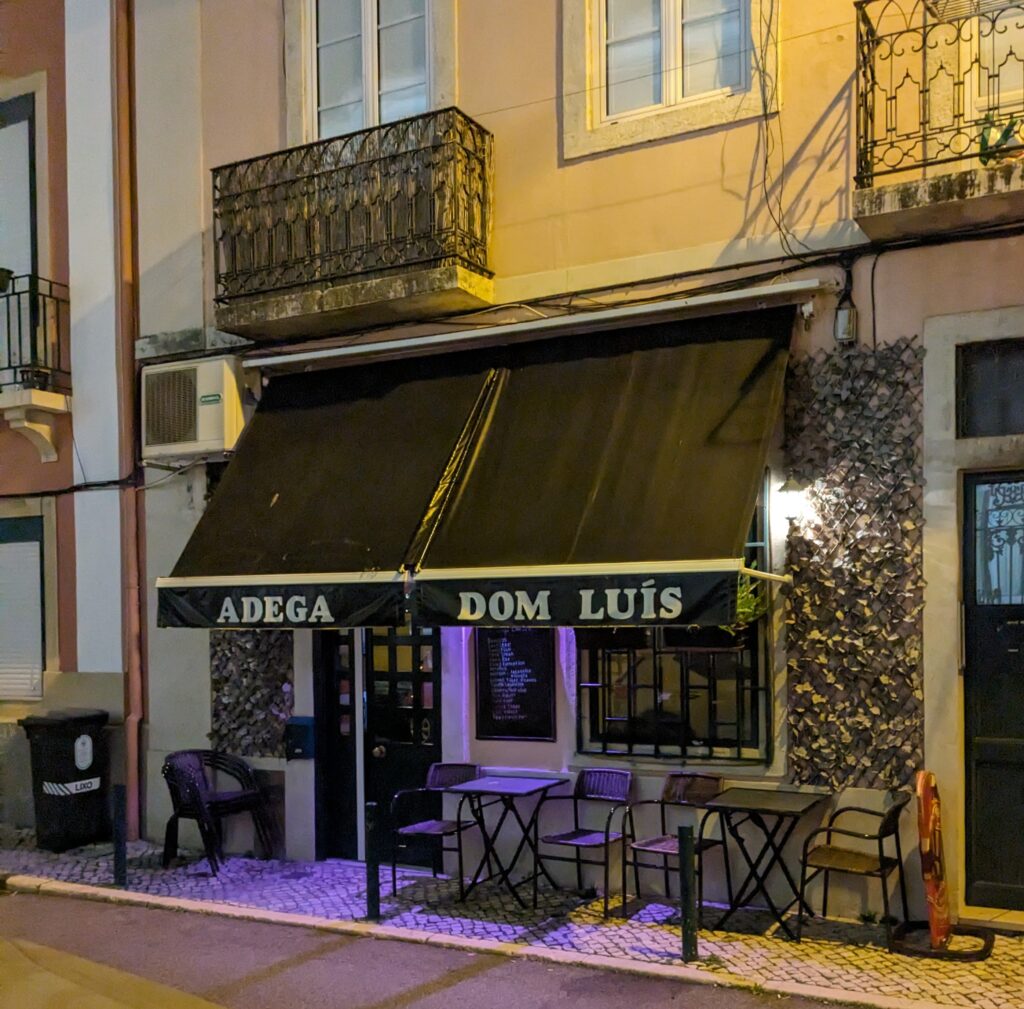
At one point, as I was umming and ahhing about what type of potatoes to order with my main, my girlfriend asked Dom Luis for his input. Having just served the table next to us with one of the potato options that I was considering (I later found out these were called batatas a murro), he grabbed a fork and without asking the gentleman next to us, skewered one of his potatoes, marched his way over to me, ordered me to ‘abre la boca’ and then shoved said potato into my mouth. I was equal parts amazed and scared by this point, so I just nodded my approval, passively confirming the choice that was so directly presented to me. Being force fed that potato was the most interesting thing that has ever happened to me in a restaurant. The potato’s previous owner was clearly a regular, and didn’t bat an eyelid throughout, as if this kind of thing was a regular occurrence at Adega Dom Luis.
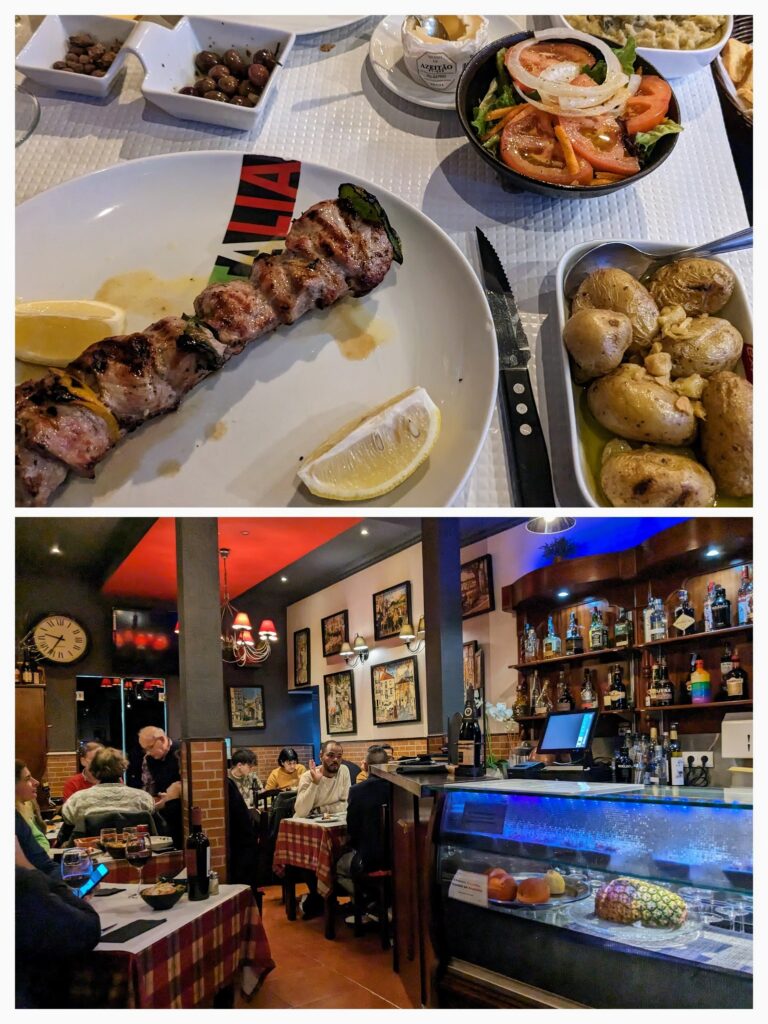
I ordered a pork kebab, which came with plethora side dishes, including creamed spinach, a type of Portuguese bread sauce, tomato salad, a wonderfully rich Quejo de Azeitão and the aforementioned potatoes which were smashed with the back of a spoon in olive oil and served with enough garlic to kill a vampire. The wine was a delightfully simple yet soft vino tinto (red) from the Alentejano region, which complemented my pork really well (also at the owner’s suggestion). Delicious cheesecake for dessert. The best bit of all though (apart from the final bill) was chatting to the man himself. We covered several topics, but mostly the challenges of a 50 year marriage, and stories of all the people he’s thrown out of his restaurant for acting like a primadonna. The world needs more Dom Luises.
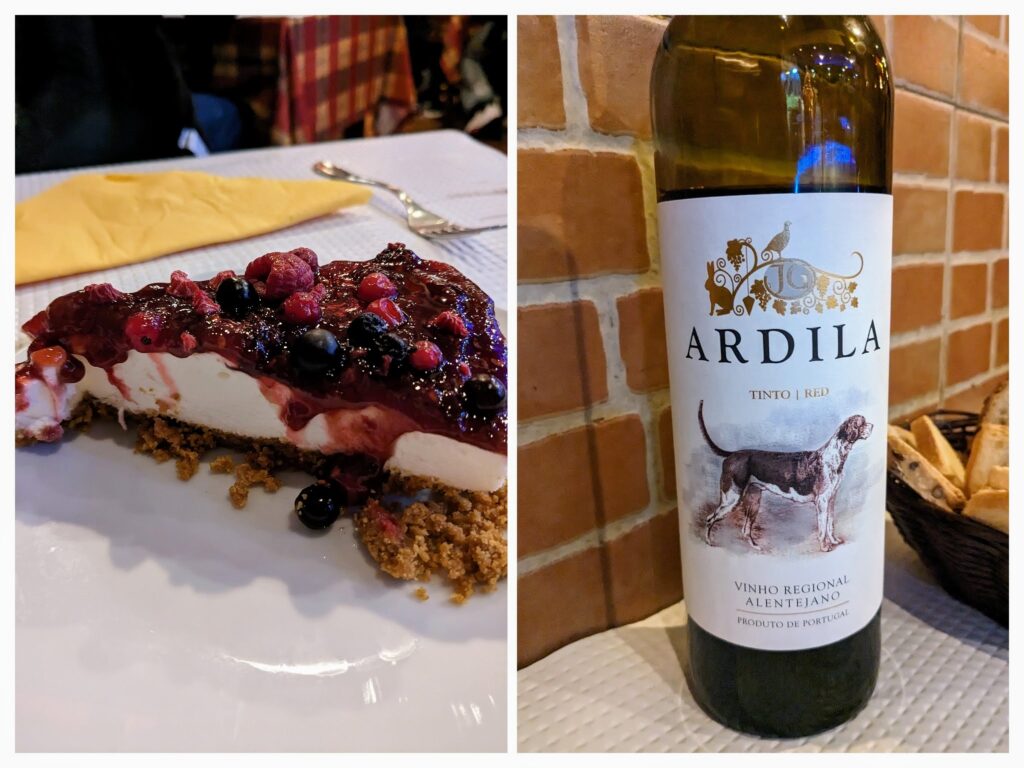
breakfast in Lisbon
Not everywhere has its own Dom Luis, so unfortunately, I don’t have quite the same confidence when it comes to advising you on the best breakfast in Lisbon. A friend of ours, however, who lives in Lisbon had recommended Dear Breakfast for Saturday morning brunch, and we weren’t disappointed. It’s clear that chefs in Lisbon take pride in all that they do, and Dear Breakfast in Chiado specialise in contemporary American/European breakfasts and brunches without charging scandalous hipster prices. Located on one of Lisbon’s hilly tram streets, the food was fantastic, and it was presented remarkably well, with so much colour on every plate. On our table there was a hearty portion of eggs benedict served with wonderfully spiced potatoes, and on the other plate maple cured bacon with pancakes, avocado and fried eggs. Exactly what we needed before a hard day of sightseeing.
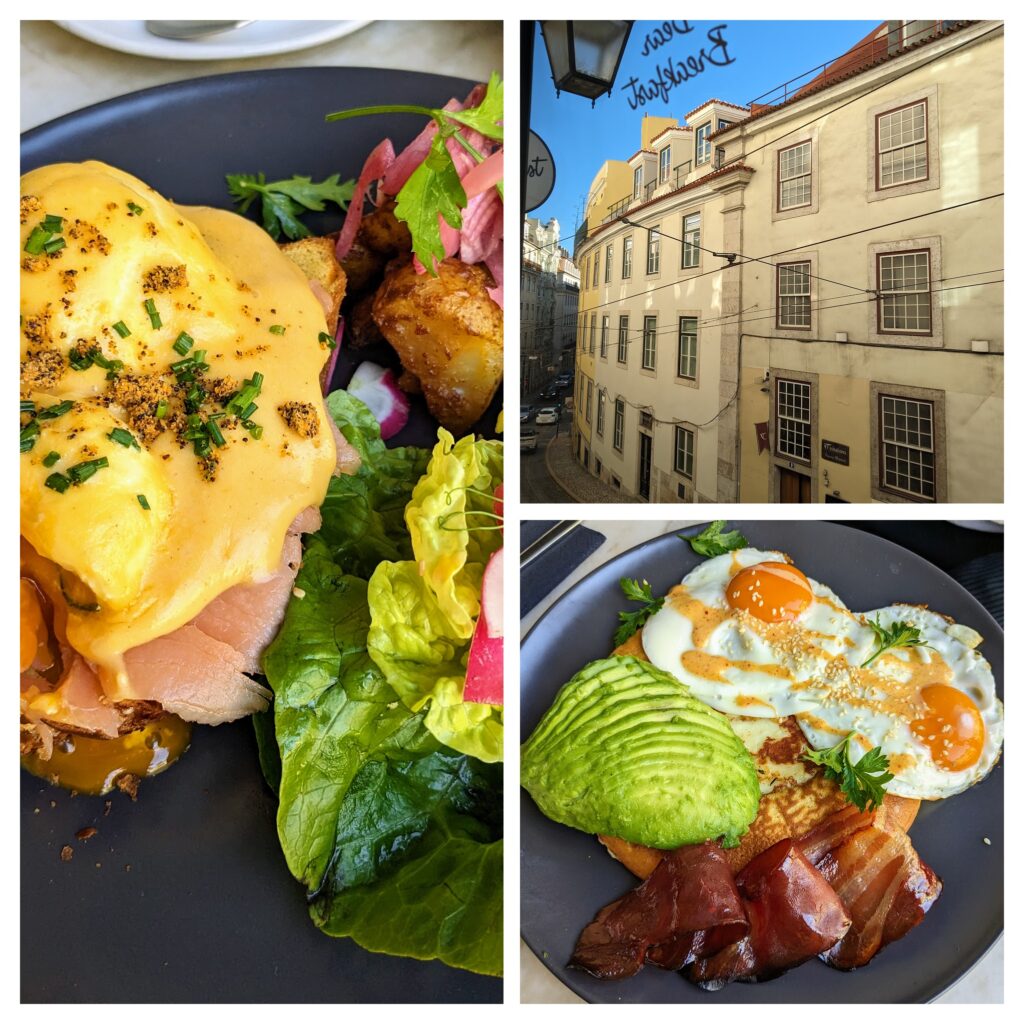
traditional food in Lisbon: the verdict
So there you have it, my guide to some of the most authentic food in Lisbon. Of course, there are so many other dishes that deserve a mention here, but this post is already long enough. Eat a few these while in the Portuguese capital and you’re on the way to lving like a local. Like I said above, do check out some of those food tours in Lisbon for a great overview of Portuguese food culture, and to get insider information on some of the best restaurants in Lisbon to visit while you’re in town. Your food tour guide should certainly have some cracking insider recommendations in that regard. Bom apetite!


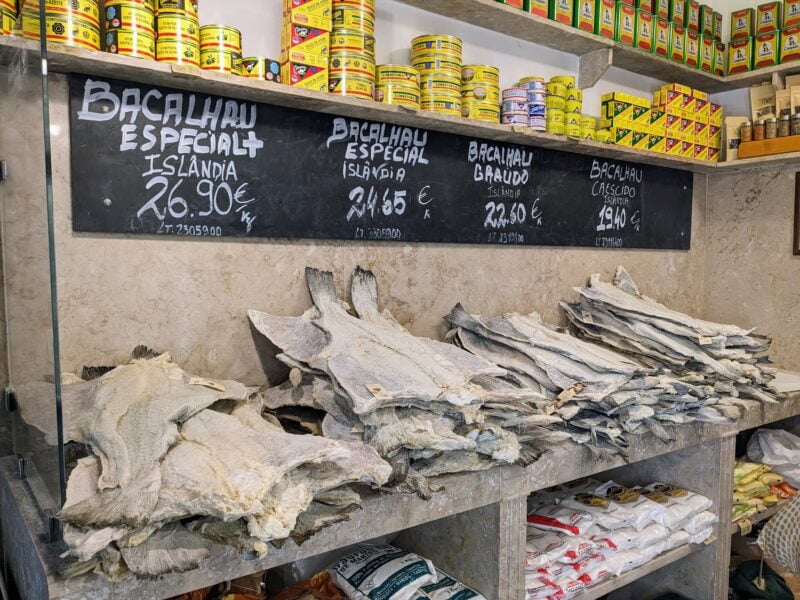



Leave a reply